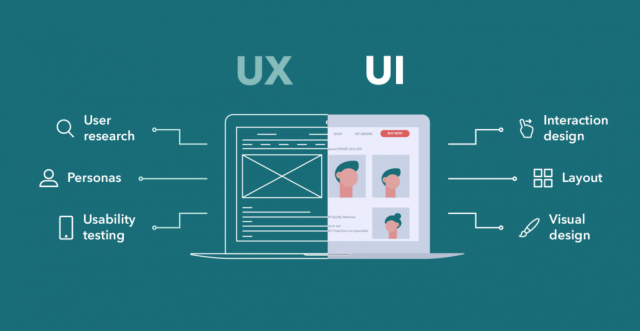In an increasingly digital world, the power of visual design has never been more evident. Visual design profoundly influences how we engage with the digital realm, from websites and mobile apps to social media, advertisements, and multimedia content. This blog explores the fundamental role of visual design in the digital age and why it matters more than ever.
Everything from websites and apps to social media content relies heavily on visual design. Businesses and organizations need visually appealing digital assets to capture their audience’s attention, resulting in an increased demand for skilled visual designers. Visual design courses are experiencing a surge in popularity for several compelling reasons, reflecting the evolving demands and interests of students, professionals, and the digital age in general.
The Role of Visual Design in Digital Communication
Visual design combines text, images, and other elements to communicate a message effectively. In the digital age, where information is abundant, and attention spans are fleeting, the role of visual design is paramount. It bridges content creators and their audience, helping convey complex ideas, evoke emotions, and guide users through the digital landscape.
At its core, visual design aims to enhance user engagement and understanding. It’s the difference between a cluttered, confusing webpage and an organized, intuitive one. A well-designed digital interface not only looks good but also functions seamlessly. Effective visual design can determine whether users stay and explore or bounce away, whether it’s a website, an app, or a social media post.
Key Principles of Effective Visual Design
To harness the power of visual design, designers adhere to fundamental principles. These principles include balance, contrast, alignment, and proximity. In the digital world, balance ensures that a webpage or app isn’t visually lopsided. Contrast helps elements stand out and grab attention. Alignment ensures that everything is neatly organized, and proximity groups related elements together. These principles provide a visual hierarchy that guides users through content effortlessly.
Consider a well-designed website, for instance. The header and navigation bar are typically at the top, creating a clear starting point. The body content is organized with headings, images, and text. The color scheme and typography are consistent, creating a cohesive brand image. These elements work together to enhance the user experience and make content more digestible.
The Impact of Color in Digital Visual Design
Color is one of the most powerful tools in a designer’s arsenal. It can evoke emotions, convey meaning, and influence user behavior. Color choices are particularly important in the digital age because screens are our primary medium for information consumption.
For example, red can signal urgency or importance, making it a popular choice for “Buy Now” buttons on e-commerce websites. Blue often conveys trustworthiness and calm, which is why it’s prevalent in the branding of many social media platforms. A successful visual design strategy incorporates color psychology to create a harmonious and effective digital experience.
Typography in Digital Design
Typography, the art of arranging and styling text, is crucial in creating a consistent brand image in the digital realm. The choice of text styles and fonts is not just about aesthetics; it’s about readability and conveying the right message.
In the digital age, readability is essential. Users often skim content, so clear, well-chosen fonts and text styles are critical to retaining attention. Whether it’s a blog post, an app interface, or an e-commerce product description, the typography must be carefully selected to enhance the user’s understanding and overall experience.
Visual Design and User Experience (UX)
User experience (UX) design is closely intertwined with visual design. UX design ensures that digital products are user-friendly, efficient, and enjoyable. As a subset of UX design, visual design plays an integral role in successfully achieving these goals.
Intuitive navigation, legible content, and an aesthetically pleasing layout are all part of creating a positive user experience. When users find a website or app visually appealing and easy to use, they’re more likely to engage with the content and achieve their goals, whether purchasing, reading an article, or simply enjoying an app’s functionality.
Mobile Responsiveness and Visual Design
The proliferation of mobile devices has necessitated a shift in how designers approach visual design. A website or app that looks fantastic on a desktop screen might be unmanageable on a smartphone. Mobile responsiveness is essential for accommodating users on various devices and screen sizes.
The challenge lies in adapting visual design elements to smaller screens without compromising the user experience. Successful mobile design retains the integrity of the brand’s visual identity while ensuring that content remains accessible and readable. In the digital age, paying attention to mobile responsiveness can significantly retain users.
Visual Design Trends in the Digital Age
The digital landscape is constantly evolving, and visual design is no exception. Design trends change as technology advances and user preferences shift. Keeping up with these trends is crucial for designers and businesses seeking to stay relevant and appealing to their target audience.
Current visual design trends often revolve around minimalism, flat design, and vibrant color schemes. Mobile app interfaces have become more intuitive, and scrolling is often favored over clicking to navigate websites. Staying informed about these trends and understanding how they apply to your project can significantly impact its success.
Case Studies and Examples
To appreciate the power of visual design in the digital age, it’s helpful to examine real-world examples. Let’s take a look at a few cases where visual design has played a pivotal role in the success of digital platforms:
Apple – Apple’s product designs are known for their clean, minimalist aesthetics. The sleek visual design of the iPhone, Mac, and other Apple products has contributed significantly to the brand’s allure.
Airbnb – The website and app are excellent examples of user-centric visual design. Their platforms are easy to navigate, and the visuals of each listing are designed to inspire trust and a sense of adventure.
Instagram – Instagram’s visual design centres around the power of images. The app’s layout is clean and straightforward, allowing the photos and videos posted by users to take center stage.
National Geographic – The National Geographic website combines striking visuals with in-depth storytelling. Their high-quality images and multimedia elements create an immersive experience for visitors.
In each of these instances, visual design has played a prominent role in captivating and retaining users, thereby adding to the overall triumph of the platform or product.Tools and Resources for Digital Visual Design
If you’re interested in harnessing the power of visual design in the digital age, there are several tools and resources available to help you get started:
Adobe Creative Cloud – It is a suite of design tools, including Photoshop, Illustrator, and InDesign, for creating stunning visuals.
Canva – An accessible online design platform that offers a broad range of templates and tools for non-designers.
Google Fonts – A collection of free, open-source fonts to be used in web design and digital content creation.
Dribbble and Behance – Online communities where designers showcase their work, share ideas, and find inspiration.
Online Courses and Tutorials – Platforms like Coursera, Udemy, and YouTube offer many tutorials and courses on visual design and related topics.
Conclusion
In the digital age, visual design is more than just aesthetics; it’s a powerful tool for communication, engagement, and memorable user experiences. From the principles of effective design to the impact of color, typography, and mobile responsiveness, every aspect of visual design plays a vital role in the success of digital projects.
Therefore, pursuing a visual design course is the best time to enter the design industry. So take the next step and enrol in a visual design course to stay ahead in the competitive job market.
Follow Technoroll for more!
Editorial Staff of the TechnoRoll, are a bunch of Tech Writers, who are writing on the trending topics related to technology news and gadgets reviews.



